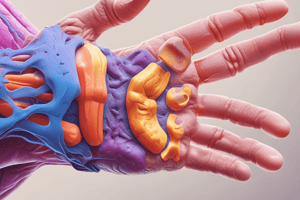Podcast
Questions and Answers
What is a key characteristic of rheumatoid arthritis?
What is a key characteristic of rheumatoid arthritis?
- Curable with proper treatment
- Affects only specific joints
- More prevalent in men than women
- Involves chronic inflammation (correct)
How does rheumatoid arthritis differ from osteoarthritis?
How does rheumatoid arthritis differ from osteoarthritis?
- Impacts multiple joints symmetrically (correct)
- Only causes morning stiffness
- Affects one joint symmetrically
- Leads to bone fusion
Why is rheumatoid arthritis considered a systemic autoimmune disease?
Why is rheumatoid arthritis considered a systemic autoimmune disease?
- It is caused by bacterial infection
- It affects various body systems (correct)
- It only affects the joints
- It primarily targets muscles
What is a potential long-term complication of untreated rheumatoid arthritis?
What is a potential long-term complication of untreated rheumatoid arthritis?
Which group is more commonly affected by rheumatoid arthritis?
Which group is more commonly affected by rheumatoid arthritis?
What is one of the diagnostic criteria for rheumatoid arthritis?
What is one of the diagnostic criteria for rheumatoid arthritis?
Study Notes
Rheumatoid arthritis (RA) is a chronic inflammatory disorder characterized by symptoms such as joint pain, stiffness, and swelling. It is an autoimmune disease where the immune system mistakenly attacks the synovial membrane surrounding the joints, causing inflammation and subsequent joint damage. Left untreated, RA can lead to joint deformities, limited mobility, and reduced quality of life.
Key Characteristics
- Systemic Autoimmune Disease: RA affects the entire body, not just specific joints.
- Chronic Disorder: It does not have a cure and requires lifelong management.
- Gender Prevalence: Women are more likely to be affected than men.
Diagnosis and Differentiators
The diagnostic criteria for RA include the presence of several specific symptoms such as morning stiffness lasting more than an hour, synovitis, rheumatoid nodules, positive test results for rheumatoid factor, and anti-citrullinated protein antibody status. Additionally, RA differs from osteoarthritis (OA) in that it tends to affect multiple joints, create symmetry in affected joints, and cause more significant morning stiffness.
Progression and Complications
RA is known for its fluctuations between periods of active disease and relative remission. However, the long-term consequences of the disease can result in severe complications, including damage to bones and joints leading to deformity, cardiovascular issues, and lung involvement.
Treatment Approach
Managing RA often requires a multifaceted approach involving medication, lifestyle changes, and supportive therapies. Drugs commonly used to treat RA include nonsteroidal anti-inflammatory drugs (NSAIDs), corticosteroids, and disease-modifying antirheumatic drugs (DMARDs) such as methotrexate, leflunomide, and biologic agents (TNF inhibitors). Regular checkups with healthcare professionals and monitoring for side effects are crucial to ensure safe and effective treatment.
Studying That Suits You
Use AI to generate personalized quizzes and flashcards to suit your learning preferences.
Description
Explore the key characteristics, diagnosis criteria, disease progression, complications, and treatment approaches for Rheumatoid Arthritis (RA). Learn about this chronic autoimmune disorder's impact on joints, symptoms, and overall quality of life.




